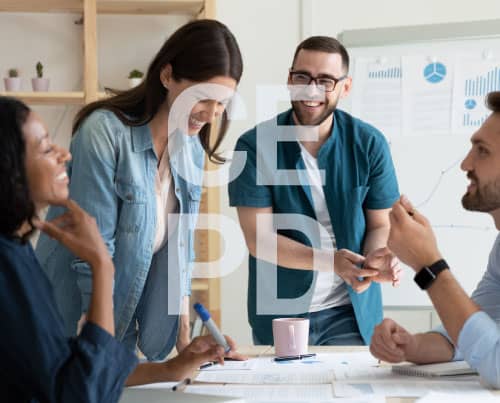Blog Post Heading
Blog Post Content
By Dan Picard
Senior Editor, MindEdge Learning
Methods for managing project knowledge tend to rely on lessons-learned databases and retrospectives. Typically, project team members gather at the end of a project or iteration, review their project journals, and document their successes and failures. But this process often catches only the generalities of a project; it doesn’t capture the nuances, specifics, and details of project work.
In a recent paper and podcast, Dr. Benjamin Anyacho suggested adapting a concept known as a knowledge café to capture and share the subtleties and implicit knowledge that is always a part of project work. A knowledge café is a small gathering of people who hold interactive discussions to uncover information that might otherwise go unnoticed. The discussions can be virtual or in-person, but they are always conversational—they are deliberately designed to be interactions, not lectures.
The Café Process
Configuring knowledge capture in a café-style setting allows for less formal interactions in a more relaxed atmosphere, so that the implicit knowledge from project work can emerge naturally. Most importantly, it allows for interaction, as participants can ask follow-up questions quickly and easily, and build upon ideas sequentially. Café participants can also exchange ideas in real time, increasing collaboration and creativity among group members.
The process for developing and holding a knowledge café is simple:
- Find a suitable place to hold the meeting. Assuming your meeting is not virtual, the meeting space should be open and large enough to fit all attendees comfortably, but not so large that it feels intimidating. It should suggest a relaxed and informal atmosphere.
- Set the boundaries for the session. Explain to all participants that the session is about sharing ideas, not debating them. Encourage them to listen first and then contribute to the conversation if they can. Encourage everyone involved to follow up their own response with a question, to get others to collaborate and discuss. The interaction should be an intentional conversation—not a lecture or a complaint session.
- If needed, provide an opening question that people can build upon. Don’t make the question too specific; rather than confining people to a specific topic, allow them to bring their own experiences and ideas into an open-ended discussion. Examples may include “What new or breakthrough ideas did you have in your last project?”; “What hidden problems did you surface as you executed your project?”; or “Were the surprises on your project good or bad? How did you avoid or capitalize on them?”
- Encourage people to explore new interactions and avenues of discussion. Remember that you are looking for the “new,” not the “comfortable.” Encourage people to ask a lot of questions and then wait for the answer. Tell them not to assume that they know the answer or to plan their response; their job is to listen.
- Look for commonalities, patterns, and trends in discussions that can be put to good use. Provide ways to illustrate ideas or capture thoughts, so this information can be retained and disseminated when the session ends.
A Second Viewpoint
Dr. Anyacho suggests having one topic that several small groups can discuss, and then bringing the results of those groups together into a larger group for expansion and dissemination of ideas. While the benefit of this process is obvious, I would suggest an even more informal way of interacting—using even smaller groups that allow for more individualized discussions and interactions.
These smaller groups would create less of a “roundtable focus group” and more of a “let’s grab a coffee and talk” connection. The interactions could be one-to-one or one-to-several, as long as the group remains especially small to allow for direct sharing of information between participants. The individual connections could allow people to adapt information from a lessons-learned or retrospective database to a specific situation, by discussing it with someone who is already experienced in a similar project. (Lessons learned or retrospective notes could also be used as a starting point to help locate an experienced coworker who can help refine project plans.) The conversations could dig deeper into details and help customize the specifics of an approach in a constructive way.
Interactive Connections
Regardless of whether the café uses a small group/large group orientation or a one-to-one interaction, these meetings will increase the speed and dissemination of knowledge sharing. Sharing becomes a direct interplay among participants, rather than an attempt to glean knowledge from a static database. Cafés may also bring together people who would not normally interact (at least, not in a typical information-sharing way) to exchange information across projects. They may unearth experts or solutions that were not known to exist, helping practitioners avoid speed bumps and making project execution smarter, simpler, and more enjoyable.
For a complete listing of MindEdge’s course offerings on Project Management, click here.
Copyright © 2022 MindEdge, Inc.
